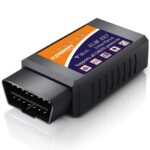For BMW E46 owners, understanding OBD2 (On-Board Diagnostics II) codes is crucial for maintaining your vehicle’s health and performance. When your check engine light illuminates, it’s signaling that your car’s computer has detected an issue. This guide will help you navigate common OBD2 problems in your BMW E46, focusing on diagnosing and resolving these effectively.
Understanding OBD2 and Your BMW E46
OBD2 is a standardized system that provides access to vehicle diagnostic data. For E46 models, typically from the late 1990s to mid-2000s, OBD2 is your gateway to understanding what’s happening under the hood. A fault code, such as those read by an OBD2 scanner, points towards a potential problem area, allowing for targeted repairs.
Common OBD2 Codes in BMW E46 and What They Mean
BMW E46s, while renowned for their driving experience, can experience common issues that trigger OBD2 codes. Among the frequently encountered codes are P0171 and P0174, both indicating a “system too lean (Bank 1 & Bank 2).” These codes suggest that the engine is receiving too much air or not enough fuel, leading to an imbalance in the air-fuel mixture. Ignoring these codes can lead to reduced engine performance, decreased fuel efficiency, and potentially more serious engine damage over time.
Troubleshooting “Running Lean” Codes on Your E46
When faced with P0171 or P0174 codes on your BMW E46, a systematic approach to troubleshooting is essential. Here are common culprits and steps to investigate:
Intake System Inspection
Vacuum leaks are a primary suspect for lean codes. Focus on inspecting the intake boots, the rubber hoses connecting the air intake to the engine. Over time, these boots can crack and degrade, allowing unmetered air to enter the system. Another component to examine is the DISA (Differential Air Intake System) valve. A faulty DISA valve, particularly the plastic pin within it, can cause air flow irregularities and trigger lean codes. Listen for any rattling or flopping sounds from the DISA valve area while the engine is running, which could indicate a failure.
Fuel System Considerations
While less frequent for lean codes compared to vacuum leaks, the fuel system should not be entirely overlooked. Consider using a fuel injector cleaner like Techron to help clear any potential blockages in the fuel injectors. Additionally, giving your E46 an “Italian tune-up”—a spirited drive with occasional high RPMs—can help clean out deposits and improve fuel delivery.
Crankcase Ventilation (CCV) System
The CCV system is notorious for failures in E46 models. A malfunctioning CCV system or a failing oil separator can create vacuum leaks and contribute to lean conditions. Check for oil residue around the oil separator and inspect the CCV hoses for brittleness and cracks. Due to its complexity, replacing the CCV system is often recommended as preventative maintenance, especially if it’s never been done.
Sensor Checks and Other Potential Issues
The Mass Air Flow (MAF) sensor measures the amount of air entering the engine. A dirty or failing MAF sensor can provide incorrect readings, leading to lean codes. Cleaning the MAF sensor with a MAF sensor cleaner is a simple maintenance step. Furthermore, inspect the throttle body and idle control valve (ICV) for carbon buildup, which can affect air intake and engine performance.
Using an OBD2 Reader for Diagnosis
Investing in an OBD2 reader is highly recommended for any BMW E46 owner. A basic, affordable OBD2 reader allows you to read and clear fault codes yourself. After performing any repairs, clear the OBD2 codes and take your car for a test drive to see if the codes reappear. This helps confirm whether the issue has been resolved.
Conclusion
Diagnosing OBD2 codes on your BMW E46, particularly lean codes like P0171 and P0174, requires a methodical approach. By systematically checking the intake system, fuel system, CCV system, and relevant sensors, and utilizing an OBD2 reader, you can effectively troubleshoot and address common issues. Embracing a DIY approach to E46 maintenance can save you money and deepen your connection with your vehicle. Remember to consult reliable resources and forums for E46-specific guidance as you work on your car.
